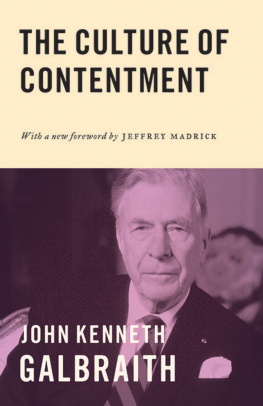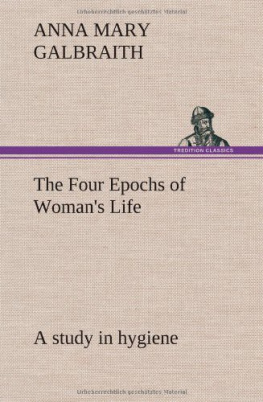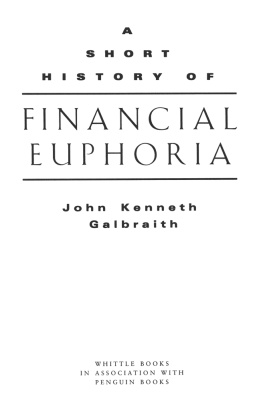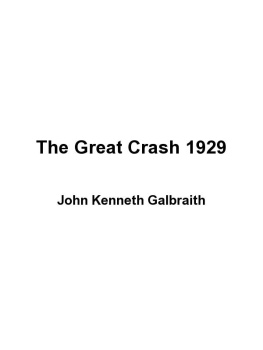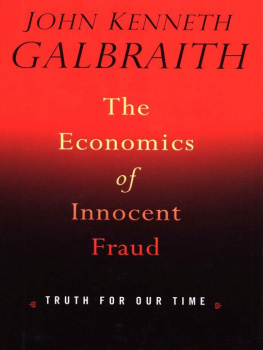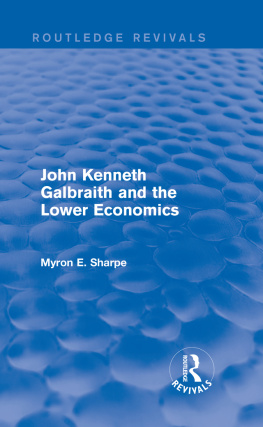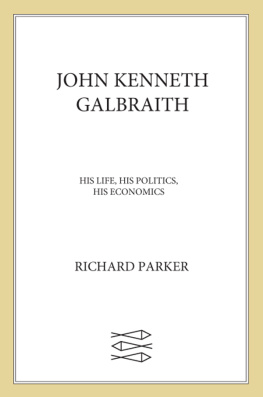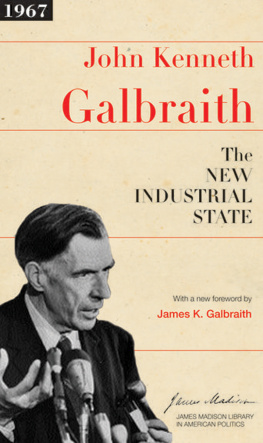Galbraith - The Culture of Contentment
Here you can read online Galbraith - The Culture of Contentment full text of the book (entire story) in english for free. Download pdf and epub, get meaning, cover and reviews about this ebook. City: United States, year: 2018;2017, publisher: Princeton University Press, genre: Politics. Description of the work, (preface) as well as reviews are available. Best literature library LitArk.com created for fans of good reading and offers a wide selection of genres:
Romance novel
Science fiction
Adventure
Detective
Science
History
Home and family
Prose
Art
Politics
Computer
Non-fiction
Religion
Business
Children
Humor
Choose a favorite category and find really read worthwhile books. Enjoy immersion in the world of imagination, feel the emotions of the characters or learn something new for yourself, make an fascinating discovery.
- Book:The Culture of Contentment
- Author:
- Publisher:Princeton University Press
- Genre:
- Year:2018;2017
- City:United States
- Rating:5 / 5
- Favourites:Add to favourites
- Your mark:
- 100
- 1
- 2
- 3
- 4
- 5
The Culture of Contentment: summary, description and annotation
We offer to read an annotation, description, summary or preface (depends on what the author of the book "The Culture of Contentment" wrote himself). If you haven't found the necessary information about the book — write in the comments, we will try to find it.
The Culture of Contentment — read online for free the complete book (whole text) full work
Below is the text of the book, divided by pages. System saving the place of the last page read, allows you to conveniently read the book "The Culture of Contentment" online for free, without having to search again every time where you left off. Put a bookmark, and you can go to the page where you finished reading at any time.
Font size:
Interval:
Bookmark:

THE CULTURE OF CONTENTMENT
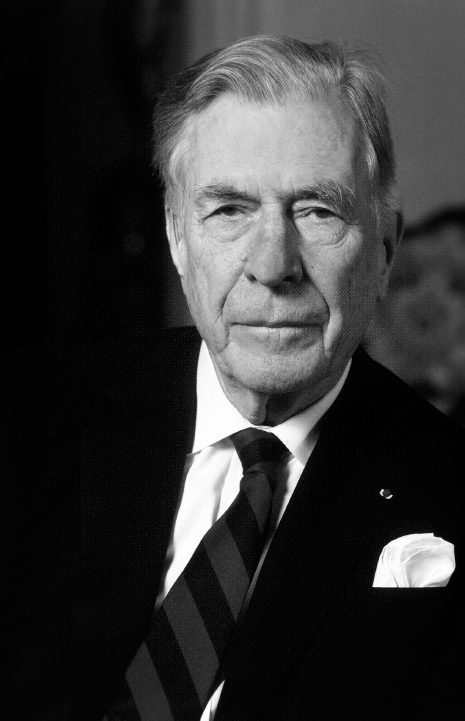
THE CULTURE OF CONTENTMENT
JOHN KENNETH GALBRAITH
With a new foreword by JEFF MADRICK
PRINCETON UNIVERSITY PRESS
PRINCETON AND OXFORD
Copyright 2017 by the Estate of John Kenneth Galbraith
Foreword copyright 2017 by Princeton University Press
Requests for permission to reproduce material
from this work should be sent to
Permissions, Princeton University Press
Published by Princeton University Press,
41 William Street, Princeton, New Jersey 08540
In the United Kingdom: Princeton University Press,
6 Oxford Street, Woodstock, Oxfordshire OX20 1TR
press.princeton.edu
Cover design by Andrea Guinn
Cover and frontispiece image courtesy of Bridgeman Images
All Rights Reserved
Library of Congress Control Number 2017945481
ISBN 978-0-691-17165-4
British Library Cataloging-in-Publication Data is available
This book has been composed in Garamond Premier Pro
and Trade Gothic LT Std
Printed on acid-free paper.
Printed in the United States of America
10 9 8 7 6 5 4 3 2 1
To Kitty once more with love
CONTENTS
Jeff Madrick |
FOREWORD
Jeff Madrick
John Kenneth Galbraiths influence among economists had been falling for a couple of decades when he published The Culture of Contentment in 1992. This book, though economically written, is a comprehensive criticism of the economic thinking that came to ascendance in the 1970s and 1980s and would continue to dominate policy for the most part in the decades that followed. Galbraith, fortunately, wasnt giving up, and he was getting back. The reissue of this book is a testament to how right he was.
Galbraith knew better than most economistsand maybe, most important, didnt forgethow government had saved capitalism time and again. The New Deal in the United States was the indelible example, with its creation of Social Security, unemployment insurance, financial regulation, union protection, jobs programs, and a belief in Keynesian budget deficits to end recessions. Aside from Keynesian economics, Britain under Prime Minister Lloyd George had undergone a similar transformation with the adoption of myriad social welfare programs before World War I. Galbraith was a champion of social democracy, as it came to be called, but he was not an enemy of capitalism. Like John Maynard Keynes, he believed government could make its best features work well.
Galbraiths central views, which he had articulated in best seller after best seller since the 1950s, had influenced the social policies of his day. Indeed, in 1972, he had been elected president of the American Economics Association, a body of august self-importance, which nevertheless believed it appropriate to so honor Galbraith.
In The Culture of Contentment, published thirty-five years after his magnum opus, The Age of Affluence, Galbraith felt obliged to defend once again the view that government measures were not merely critical to social good and political stability, but to prosperity as well. Once he was among the most cited economists in the world, but as he continued to defend a robust welfare state, the evolving mainstream profession moved in the other direction. He knew this all too well, and one supposes his frustration was difficult to constrain. But Galbraith was right, and the mainstream was wrong. To todays readers, this book provides a history and also a guide to social justice and economic prosperity that the United States has failed to followto its detriment.
The Culture of Contentment may well be the most important testament to the correctness of Galbraiths thinking, because it stood courageously in direct contrast to the antigovernment, allegedly scientific consensus that by 1992 leaned decidedly toward laissez-faire governance. How wrong that consensus has been is most evident in the financial disaster of 2008, but when its advocacy of deregulation, singular attention to inflation, and neglect of fiscal policy not only spawned the crisis but also contributed significantly to slow wage growth, inequality, high poverty levels, and a lack of adequate public investment, leaving its mark vividly in the disturbingly slow rate of productivity growth over the last decade.
The inflationary crisis in the 1970s opened the sluices for the economic consensuss turn to the Right. The foundational idea of this shift was that private markets were self-correcting, and moreover created an ideal path to prosperity, because of the power of the invisible hand. An ideal (equilibrium) price for a product would be found through the interaction of buyers and sellers, which would benefit all throughout the economy of thousands of individual marketplaces. This was known as general equilibrium theory, which we discuss later. Government regulation of prices, quantities, or borrowing would simply muck up the works. Government social programs, in turn, were typically thought of as dead weight, and thus as losses to the nations income. Worse, any resulting federal deficit for social policy expenditures was seen as inflationary, especially if it was financed by money creation from the Federal Reserve. With high inflation and simultaneously high unemployment in the 1970s, it was then easy, if unjustified, to proclaim that Keynesianism was failing and that government was the problem.
At its most basic, The Culture of Contentment is an indictment of economic policies under Presidents Ronald Reagan and George H. W. Bush, which followed along the lines of this new economic consensus, but the book also stands as a criticism of the policies to come under Presidents Bill Clinton, George W. Bush, and, to some degree, Barack Obama. In the era when Galbraith published the book, the oversimplified theory that minimal government was the best government was considered almost incontestable. Between 1990 and 1997, basically every economist who won the Nobel Prize, most of whom were either graduates of or associated with the University of Chicago, had just such a utopian faith that unregulated markets in pursuit of price equilibrium would optimize outcomes for everybody. Some of these economic claims were extreme, in particular the notion among rational expectationists that government policy had no influence on prices at all. In fact, the more unconventional the theory, the better, because then it ironically served as proof that such thinking was scientific. And as in science, great hypotheses, such as those of Galileo, Copernicus, and Einstein, often defied common sense and were scorned.
Even corruption could not exist in this laissez-faire utopia. The 1992 winner of the Nobel Prize in Economics, University of Chicago professor Gary Becker, wrote in a Newsweek column that if we abolished government, we would abolish corruption. And in practice, Federal Reserve Chairman Alan Greenspan did not pursue fraud allegations in the early 2000s against the subprime mortgage writers the FBI had warned him about, because he believed markets would minimize fraud on their own. If someone was charging too high or too low a price, he or she would be undercut by a competitor or take a loss on a bad risk and surely not repeat the mistake. Businesspeople couldnt possibly be so unintelligent as to continue to make irrationally risky decisions!
Most of the mainstream believed they had now solved the problem of maximizing economic growth in the United States. After the inflationary ravages of the 1970s, the governments main economic objective was seen as subduing inflation, and Greenspan made this his priority. His successor a decade and a half later, Professor Ben Bernanke of Princeton, was one of the key theorists behind inflation-targeting policy. If only inflation were low, he believed, the magical workings of the free market would maximize productivity and prosperitynot to mention ensure a fair distribution of economic gains. Reducing the federal budget deficit, which had been sharply inflated by Ronald Reagans tax cuts, was also a central element of this thinking. Big deficits were seen to stimulate inflation by creating too much demand and pushing up interest rates, which crowded out private investment.
Next pageFont size:
Interval:
Bookmark:
Similar books «The Culture of Contentment»
Look at similar books to The Culture of Contentment. We have selected literature similar in name and meaning in the hope of providing readers with more options to find new, interesting, not yet read works.
Discussion, reviews of the book The Culture of Contentment and just readers' own opinions. Leave your comments, write what you think about the work, its meaning or the main characters. Specify what exactly you liked and what you didn't like, and why you think so.

